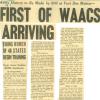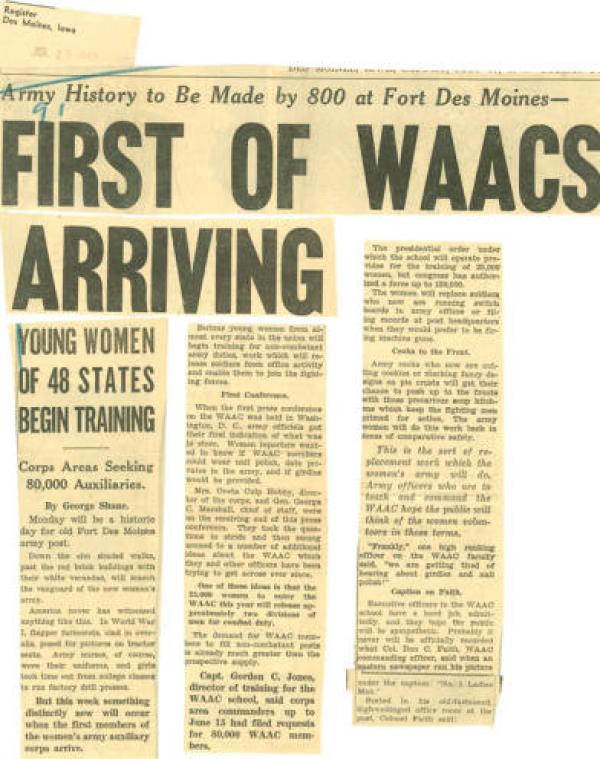Fort Des Moines
| Grade | 9th -12th Grades | Class | U.S. History | Length of Lesson | 50 Minutes |
| Lesson Title | Fort Des Moines |
| Unit Title | History of Iowa |
| Unit Compelling Question | In what ways has Iowa contributed to U.S. History? |
| Historical Context: 2018.052.004 his article was published in the Des Moines Register on July 19th, 1942. The article refers to the WAAC or the Women's Auxiliary Army Corps arrival to Fort Des Moines to take over for soldiers in administrative posts. These women were trained in combat but were in charge of administrative roles in forts such as Fort Des Moines. With things taken care of back at home, the soldiers could join the battlefield. ### Fort Des Moines was built in 1843 at the intersection of the Des Moines and Raccoon River. Fort Des Moines established itself as an important military base that played a major role in the Civil War and both world wars. The facility was vacated in 1846. In 1901, Fort Des Moines was revived as the Fort Des Moines Provisional Army Officer Training School located on the south side of Des Moines. It became the only training site for African American officers in the nation. During the early 1900s, the fort housed the 25th Infantry Prison Guard, as well as the 11th, 2nd, and 6th US Cavalry Regiments. In 1916, these Cavalry Regiments left for service at the Mexican border. In their place, the camp trained 1,250 African American men, all who had college degrees, to become US military officers. These men were paid seventy five dollars in gold coin. A white officer, Lieutenant Colonel Charles C. Ballou, commanded all of the African American soldiers at Fort Des Moines. These men would eventually be sent to Europe to fight in the First World War. (Iptv.org) The fort would play a major role in World War II as well. In 1942 the Army opened an officer training school for women at Fort Des Moines. During World War II, Fort Des Moines served as a military training center for the Women's Army Auxiliary Corps (WAAC), later renamed the Women's Army Corps (WAC). The fort, as well as other neighboring facilities, started with 11,000 new female recruits and successfully trained 72,141 women including a small contingent of African American female officers. After the war, Fort Des Moines became a separation center for the WAC. (Schwieder, 280-281) Eventually the fort would become a post for the US Army Reserve. The fort also became a National Historic Landmark in 1974. During the Vietnam War, Fort Des Moines would become the location of the Des Moines Armed Forces Examining and Entrance Station. The fort closed its doors in 2008. (Militarybases.com) Today, the buildings serve as a Correctional facility, as well as apartment buildings. There is also a Fort Des Moines Museum and Education Center. Resources: http://www.iptv.org/iowapathways/mypath/black-officers-fort-des-moines-… |
|
| Lesson Supporting Question | |
| Lesson Overview | Fort Des Moines in Des Moines has a played a large role in not only Iowa History, but in U.S. History as well. Along with being a training facility among the first for African American soldiers in WWI, it was also used in WWII for training WAAC (Women’s Army Auxiliary Corps). At first only white women were accepted into training but soon women of all races were accepted at Fort Des Moines for training. During this time, most of the United States was very segregated and at first Fort Des Moines started out that way too with separate barracks for White women and African American women. The Army insisted that WAAC training was not discriminatory and any women who had enlisted would be getting the same training. Shortly after the women of the WAAC arrived, they decided to no longer segregate the women. The WAAC training and desegregation was huge for its time and should be celebrated along with other ways that Iowa has impacted U.S. history positively. This lesson would be a good way to educate students on parts of Iowa history that they might not be familiar with and help them see Iowa’s connection with the rest of the nation in National events. |
| Primary Sources Used |
|
| Resources Needed | Primary resource news paper text. (see attached) handouts for the whole class This can be found on this site: http://128.255.22.135/cdm/ref/collection/wwii/id/1208 Shane, G. (1942, August 19). Army history to be made by 800 at Fort Des Moines - first of WAACs arriving. The Des Moines Register. Retrieved April 12, 2018, from http://128.255.22.135/cdm/ref/collection/wwii/id/1208 A projector or smartboard to play the YouTube clip You tube clip about Fort Des Moines C-SPAN Cities Tour - Des Moines: Historic Fort Des Moines . (2014, July 18). Retrieved April 12, 2018, from https://www.youtube.com/watch?v=qpEvix6FS-8 Handouts of the worksheet |
| Standard | |
| Lesson Target | Students will understand how Fort Des Moines was instrumental in training women for WWII .;Students will analyze the language used in the newspaper article and understand the historical language and context of the time to realize how it relates to gender at the time. |
| Lesson Themes | |
|
| Formative Assessment (How will you use the formative assessments to monitor and inform instruction?) |
Ask questions periodically to check for understanding. , After the clip, ask discussion questions to gage where the students are at in their connections and understanding. |
| Summative Assessment (How does the lesson connect to planned summative assessment(s)?) |
There will be a handout that will have questions that will be answered while the students are reading the primary source. The handout is found at the end of the lesson plan. |
| Author | Chad Timm | Created | Last Edited | ||||
| Reviewer: Dr. Chad Timm, Simpson College | |||||||
| Lesson Plan Development Notes: Dr. Chad Timm, Simpson College | |||||||


